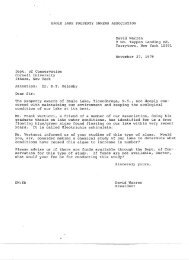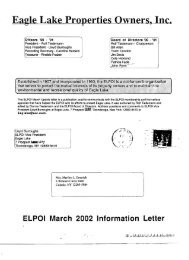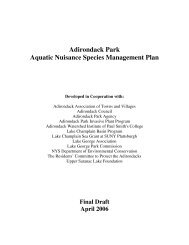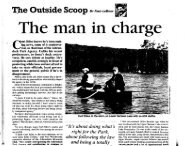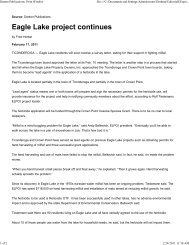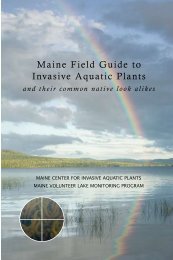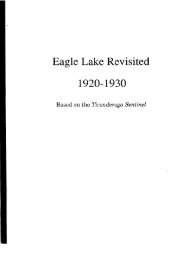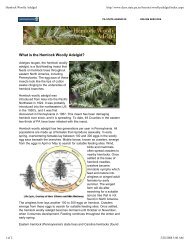SEIS - Eagle Lake Property Owner's Inc.
SEIS - Eagle Lake Property Owner's Inc.
SEIS - Eagle Lake Property Owner's Inc.
Create successful ePaper yourself
Turn your PDF publications into a flip-book with our unique Google optimized e-Paper software.
PROPOSED ACTIONFluridone (l-methyl-3-phenyl-5-[3-(trifluoromethyl)phenyl]-4[IH]-pyridinone) is a systemicherbicide. It is absorbed by plant tissues and translocated throughout the plant. Fluridone, theactive ingredient in Sonar®, was introduced in 1979 (Arnold, 1979), obtained Federal registrationin 1986, and has been in widespread use outside New York since the late 1980s. Althoughspecial use based on local needs was possible in New York in 1993, full use in New York wasnot approved prior to 1995, and changes in label restrictions for New York have continued untilthe present time.Sonar® currently comes in two formulations, an aqueous suspension (Sonar® AS) and a slowrelease pellet (Sonar® SRP). Sonar® AS is proposed for use in this project. This chemical inhibitscarotene synthesis, which in tum exposes the chlorophyll (active photosynthetic pigment) tophotodegradation. Most plants are negatively sensitive to sunlight in the absence of protectivecarotenes, resulting in chlorosis of tissue and death of the entire plant with prolonged exposure(up to 40 days) to a sufficient concentration of fluridone (as little as 5 ppb). Some plants,including Eurasian watermilfoil, are more sensitive to fluridone than others, allowing selectivecontrol at low dosages.F or susceptible plants, lethal effects are expressed slowly in response to treatment with fluridone.Existing carotenes must degrade and chlorosis must set in before plants die off; this takes severalweeks to several months, with 30-90 days given as the observed range of time for die off to occurafter treatment. Fluridone concentrations should be maintained in the lethal range for the targetspecies for at least three weeks, and preferably for six weeks. This presents some difficulty fortreatment in areas of substantial water exchange, but the slow rate of die off minimizes the risk ofoxygen depletion.The list of submersed vascular plants known from <strong>Eagle</strong> <strong>Lake</strong> (Table 1) includes 36 species.Two non-vascular species (macroalgae) are also listed. Comparison of this list withsusceptibility evaluations compiled by the Vermont DEC (1995) and the current supplier ofSonar® (SePRO 1995) indicate that Eurasian watermilfoil and up to 11 other species would besusceptible to treatment with fluridone. Based on available information, there are 4 or 5 speciesthat would be unharmed, leaving 22 speCies for which available information is insufficient tomake any prediction of fluridone impact. Similar indications are provided by the data fromMichigan as reported in the GElS (Table 2). While the selectivity of fluridone for milfoil andcertain other nuisance species has been demonstrated in many studies, there is apparently littledocumented experience with many of the plant species in <strong>Eagle</strong> <strong>Lake</strong>. Any information frommonitoring plant species in any area treated might therefore be helpful to expand the database onfluridone effects.D<strong>SEIS</strong> for <strong>Eagle</strong> <strong>Lake</strong> 12 ENSR



